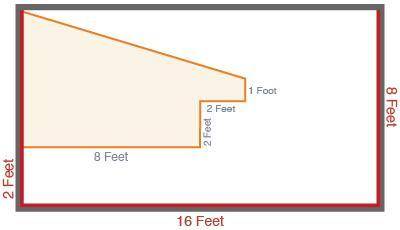
Mathematics, 01.02.2021 21:40 cameronbeaugh
WILL GIVE BRAINLEIEST PLEASE EXPLAIN IT TO HELP ME UNDERSTANDThe figure below shows a shaded region and a non-shaded region. Angles in the figure that appear to be right angles are right angles.
A picture of a rectangle is shown. The bottom of the rectangle is labeled 16 ft. The right side of the rectangle is labeled 8 ft. At the bottom left side of the rectangle there is a label that reads 2 ft. Inside the rectangle is a shaded region. The bottom of the region is labeled 8 ft and this side is perpendicular to the left side of the rectangle. The right side of the shaded region has a perpendicular line segment extending upward that is labeled 2 ft. At the top of this line segment is another line segment perpendicular to the right that reads 2 ft. At the end of this line segment is a perpendicular line segment extending upward that reads 1 ft. There is a line segment joining the end of this line segment with the top left corner of the rectangle.
What is the area, in square feet, of the shaded region?


Answers: 3


Another question on Mathematics

Mathematics, 21.06.2019 15:10
Polygons efgh and e′f′g′h′ are shown on the coordinate grid: what set of transformations is performed on efgh to form e′f′g′h′? a. a translation 1 unit to the left followed by a 90-degree counterclockwise rotation about the origin b. a translation 1 unit to the right followed by a 90-degree counterclockwise rotation about the origin c. a 90-degree clockwise rotation about the origin followed by a translation 2 units to the right d. a 90-degree clockwise rotation about the origin followed by a translation 2 units to the left
Answers: 1

Mathematics, 21.06.2019 20:00
Axel follows these steps to divide 40 by 9: start with 40. 1. divide by 9 and write down the remainder. 2. write a zero after the remainder. 3. repeat steps 1 and 2 until you have a remainder of zero. examine his work, and then complete the statements below.
Answers: 1

Mathematics, 21.06.2019 20:30
Does the function satisfy the hypotheses of the mean value theorem on the given interval? f(x) = 4x^2 + 3x + 4, [−1, 1] no, f is continuous on [−1, 1] but not differentiable on (−1, 1). no, f is not continuous on [−1, 1]. yes, f is continuous on [−1, 1] and differentiable on (−1, 1) since polynomials are continuous and differentiable on . there is not enough information to verify if this function satisfies the mean value theorem. yes, it does not matter if f is continuous or differentiable; every function satisfies the mean value theorem.
Answers: 1

Mathematics, 22.06.2019 00:30
Find the length of the radius of a circle with the center at -7+2i and a point in the circle at 33+11i
Answers: 1
You know the right answer?
WILL GIVE BRAINLEIEST PLEASE EXPLAIN IT TO HELP ME UNDERSTANDThe figure below shows a shaded region...
Questions

History, 06.04.2021 15:20





Mathematics, 06.04.2021 15:20







Health, 06.04.2021 15:20





Biology, 06.04.2021 15:20

Mathematics, 06.04.2021 15:20



